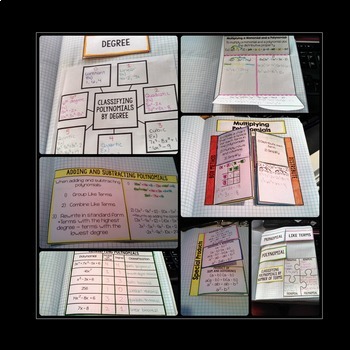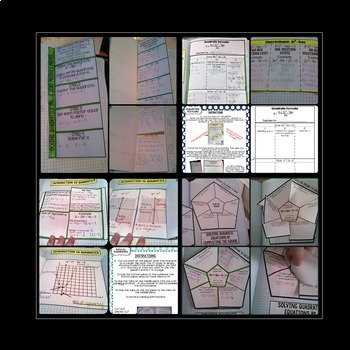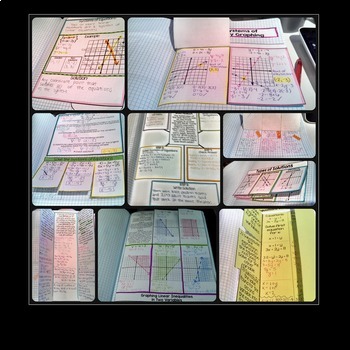Algebra 1 Interactive Notebook Bundle
- PDF
What educators are saying
Description
This is a set of 80+ printable pages for Algebra and Pre-Algebra Interactive Notebooks. Instructions with pictures are included for every page! This bundle is made up of foldable pages, flippable pages, graphic organizers, maps and more. The bundle is too large to host on Teachers pay Teachers so it is hosted on Dropbox. Upon purchasing the bundle a pdf page that includes a link to the bundle on Dropbox will be available for download. Instructions are included that will lead you through the simple Dropbox download process.
Pages Included Are:
Introduction to Algebra Folder:
♦The Real Number System
♦Absolute Value
♦Identifying Parts of an Expression
♦Distributing
♦Simplifying Expressions
♦In other words….. (Words Used to Translate Expressions)
♦Translating Expressions
♦Practice Solving One Step Equations
♦Solving & Graphing One Step Inequalities
♦Practice Solving & Graphing One Step Inequalities
Equations and Inequalities Folder:
♦ Equations with Variables on Both Sides
♦ Solving Equations: Special Cases {Infinite & No Solutions}
♦ Multi Step Equation Practice
♦ Properties of Equality
♦ Proportions (Vocab & Instruction)
♦ Absolute Value Equations
♦ Representing Inequalities & Their Answers (Set & Interval Notation)
♦Solving and Graphing Multi Step Inequalities
♦ Interpreting Absolute Value Inequalities
Linear Equations Folder:
♦ Finding Slope From a Graph, Table, and 2 Points
♦ Creating a Table of Values & Writing Linear Equations From a Table
♦ Converting from Standard to Slope Intercept Form of a Line
♦ Graphing Using Slope Intercept Form of a Line
♦ Writing Linear Equations From a Graph
♦ Writing Linear Equations Given 2 Points
♦Horizontal and Vertical Lines
♦ Point Slope Form of a Line
♦Parallel and Perpendicular Lines
Exponents and Scientific Notation Folder:
♦ Introduction to Exponents
♦ Power of a Power & Power of a Product Properties (2 options)
♦ Quotient of Powers Property (2 options)
♦ Power of a Quotient Property
Systems of Equations and Inequalities Folder:
♦ Introduction to Systems of Equations
♦ Solving Systems of Equations By Graphing
♦ Solving Systems of Equations By Substitution
♦ Solving Systems of Equations By Elimination
♦ Solving Systems of Equations Word Problems
♦ System of Equation Word Problem Practice
♦ Graphing Linear Inequalities
♦ Solving Systems of Linear Inequalities
Polynomials Folder:
♦Classifying Polynomials By Number of Terms
♦Classifying Polynomials By Degree
♦Classifying Polynomials
♦Adding and Subtracting Polynomials
♦Multiplying a Monomial & a Polynomial
♦Multiplying Binomials By Distributing
♦Special Cases: Multiplying Binomials
♦Dividing a Polynomial by a Monomial
Quadratics Folder:
Radicals Folder:
♦Introduction to Simplifying Radicals
♦Adding and Subtracting Radicals
Others:
♦Introduction to Relations and Functions
♦Function Notation and Evaluating Functions
♦Factoring Polynomials by Finding GCF
♦Factoring Polynomials: Box Method
♦ Exponential Functions
♦ Exponential Growth and Decay Functions
Click on the links above to preview pages OR download the preview for this resource to find clickable links leading to previews.
If you have any questions please email: randi@4theloveofmath.com!
****If you have purchased individual pages (or bundles) in the past and would like to upgrade to this all inclusive bundle please send an email subject line "Upgrade please" with your TpT username plus a list of items purchased with dates. I will do my best to search my records by username but some usernames are not searchable on my end! I can then arrange with you to lower the price for the bundle so you do not pay for items twice****
*********************************************************************
Terms of use:
This item is a paid digital download. As such, it is for use in one classroom (or by one teacher) only. This item is bound by copyright laws and redistributing, editing, selling, or posting this item (or any part thereof) on the Internet are all strictly prohibited without first gaining permission from the author. Violations are subject to the penalties of the Digital Millennium Copyright Act.
*********************************************************************





